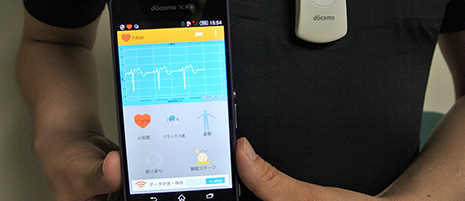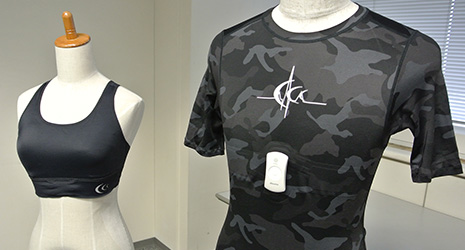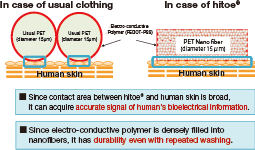Home > Highlighting JAPAN > Highlighting Japan August 2016 > Science & Technology
Highlighting JAPAN


Wearable Sensors for All
A new material that can measure biological information such as heart rates and electrocardiograms is finding utility in fields as diverse as sports training programs and security management.
Toray Industries, Inc. and Nippon Telegraph and Telephone Corporation (NTT) have successfully commercialized a functional material called “hitoe®” that is capable of detecting biomedical signals at a high level of sensitivity. hitoe® features a coating of conductive polymer with a fiber diameter of 700-nanometers (one-7,500th the width of a human hair) developed by Toray with the use of NTT’s technique for fabricating conductive textiles.
“hitoe® can read electric signals transmitted by the body,” says Seiji Kuno of NTT’s Research and Development Planning Department. “It can be used as both a sensor and fiber.”
People who wear clothes embedded with hitoe® material can have their biomedical signals sent through hitoe® to a special small transmitter. From there, the data are transmitted to a smartphone or personal computer.
One feature of hitoe® is that it clings to the skin easily. Since the contact area between hitoe® and human skin is broad, it can accurately detect biomedical signals transmitted by the body. In addition, it is so durable that the user can wash the material 100 times.
Measuring the successive number and fluctuation of heart rate is necessary to accurately understand physical and psychological conditions. When a conventional electrode is used, measurements are performed by attaching it to the skin with an electrolyte gel. However, if the patient sweats, the electrolyte gel washes off the skin, while the gel can also cause itchy skin and rashes, making it impossible to conduct measurements. Due to these defects, conventional methods were unsuitable for continuous use over an extended period of time, or when the patient was sweating profusely. hitoe® works around these problems and makes it possible to conduct measurements simply by wearing clothes.
NTT and Toray intend to use these features of hitoe® and apply it to many areas, the first of which is sports. The use of heart rate data to monitor the stress placed upon the body helps athletes to train more efficiently. In addition, the visualization of how muscles are used during physical exercise by electromyography reveals the difference in muscle use between more experienced athletes and beginners. The creation of a visual reference helps athletes improve their skills, avoid injury and develop training methods. This makes it possible to monitor physical conditions all the time through sports and diet, leading to better and more efficient performance results.
The second use is within the realm of security management for workers. For example, workers on a construction site and an airport have been asked to wear hitoe® material-embedded clothes in the summer heat. As they work, their heart rates and other measured physical data are monitored in real-time by the administrators at the office. The data obtained reveal the degree of heat exposure the workers are experiencing and other related data. It is being considered to use hitoe® material-embedded clothes to help manage the physical conditions of workers and prevent accidents by transmitting acquired data via the cloud to PC terminals, tablets and smartphones and to share the information with workers and administrators.
“The small transmitter in the clothes contains an embedded tri-axial acceleration sensor,” says Kuno. “It can immediately sense when a person wearing these special clothes trips and falls, making it possible to send someone to their aid.”
The third use is in the medical field. It is not always possible to detect unusual symptoms in patients with heart disease through short-time measurement by electrocardiograms. Long-time measurement using electrocardiograms currently requires a Holter monitor to constantly record electrocardiograms 24 hours a day. Unfortunately, a Holter monitor requires patients to wear a large number of electrodes and cords at all times, causing problems in their daily lives.
Clothes for medical use embedded with hitoe® material make it possible to conduct measurements simply by wearing clothes. Such clothes can constantly monitor electrocardiograms while allowing patients to go about their daily lives hassle-free. In the future, the continuous measurement of heart conditions for more than one week at home will help to discover potential heart diseases that were difficult to detect with the conventional Holter monitor. The research and development has been conducted to make use of hitoe® in medical settings.
“In the future, we also aim to use hitoe® in combination with GPS and beacons in caring for the elderly at nursing care and welfare facilities and homes,” says Kuno.
© 2009 Cabinet Office, Government of Japan







